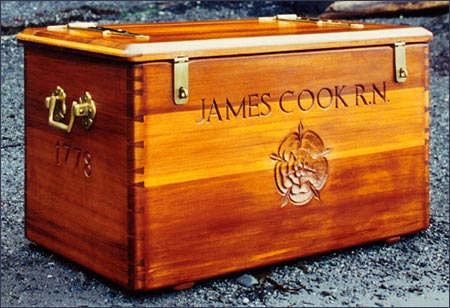 |
||||||||||||||
|
|
||||||||||||||
Sea ChestReplica of the sea chest made for Captain James Cook, 1778
41 in. x 22½ in.(w) x 23 in. This strongly constructed chest is made in the traditional manner, to replicate a chest made in 1778 for James Cook at Nootka Island. The material is old growth red cedar. It is a full one and a half inches in thickness throughout. The wide panels for this chest have been made up from narrower boards jointed together in 'slape' fashion. The main carcase has dovetailed corners, which are 'lapped' on the inside to accommodate the groove, into which the bottom panel of the chest fits. The bottom panel is solid red cedar and is mounted loosely. It is bevelled to allow for movement in the supporting woodwork as shrinkage occurs. The top of the chest includes the lid and a batten to which it is fixed, with tee shaped strap type hinges. The brass hinges extend across the lid to impart some structural integrity, since they are bolted through to stout brass backing blocks on the underside of the lid. The lid is further reinforced with an oak spline at each end which tends to keep the lid flat. Two hasps are provided for security; these are made of cast brass. This chest bears the name of 'James Cook', carved deeply on the front panel. No rank is indicated, simply the initials R.N. for Royal Navy. Also incised on the front of the chest is a Rose of York. James Cook was a native of Yorkshire. The White Rose is Yorkshire's emblem, and it is fitting for a famous son. The two end panels are also carved, one with the name Nootka, the other bears the date 1778. All the hardware has been cast from specially made patterns. The hinges are screwed and riveted in place. The handles have massive brass backing blocks to support them. The chest sits upon two oak skids, to keep it above a wetted deck, and to protect the bottom cedar panel. The chest is finished with a soft oily varnish, typical of the eighteenth century. It is a handsome piece, and though originally designed to store two naval greatcoats, it has a capacity for more, as well as precious objects. |
||||||||||||||
| courses : tools : school : principal teacher : gallery : home | ||||||||||||||
|

